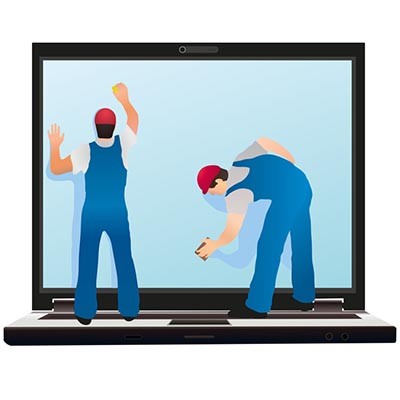Tip of the Week: Properly Cleaning a Laptop
If you’re viewing this page on a laptop right now, I have some bad news. Studies have indicated that the keyboard you’ve been typing on is actually dirtier than a toilet seat. Pretty gross, huh? However, the last thing you want to do is ruin your laptop as you clean it… that’s why we’re reviewing the process of safely cleaning it – starting from the screen and moving on from there.
Screen Cleaning
Microfiber Can Safely Clear Away Dust
The screen you’re likely viewing this on is less resilient than you might think – meaning you should resist the urge to grab anything that’s handy and just start scrubbing away. In a perfect world, you would have access to a microfiber cloth, which is the ideal material to clear dust from your screen with. If you find yourself without microfiber, you can substitute other, clean pieces of cloth, although you may leave a few pieces of lint behind. However, you should NEVER use paper towels or tissues to dust your display – and you shouldn’t press too hard, either. It would be a shame if you damaged your screen by being too heavy-handed.
Polishing the Screen
Now that all the dust is cleared away, you’ll want to get rid of any smudges. Since we’re working with an electronic device, we have to be incredibly careful with any water we use. Distilled water doesn’t conduct electricity as well as standard water does (because science), so this is a better choice. Soaking a clean sponge in distilled water and wringing it out until it’s almost dry, you’ll have what you need to very delicately wipe off your screen. If spots persist, add a tiny bit of gentle dish soap to your water – you just want to make sure that if you’re dealing with a touchscreen, the soap won’t remove its finish.
If you don’t want to bring water into contact with your device, there are a few other options you can consider. Any cleaning wipe without ammonia or bleach is a safe bet. You won’t want to use any commercial glass cleaners on your device.
If you want to get really official, there are kits made specifically for cleaning your devices’ screens (including your laptop’s) that you can pick up. A few quick circles with a clean microfiber cloth can get rid of any streaks once you’re done.
Keyboard Cleaning
Removing Debris
The main reason that a keyboard gets dirty is the debris that can make its way between the keys. If you’ve ever cleaned out a computer’s keyboard by flipping it upside-down and shaking it, you know how to clean your laptop’s keyboard. Obviously, you will want to be exceptionally careful as you hoist your upside-down laptop to shake it. It can also help to tilt the device to really encourage the grime to dislodge.
(Compressed) Airing It Out
Not everything is going to shake out effectively, which means that you’re going to have to bring in some relatively heavy artillery: compressed air. Angling it at a 75-degree angle to avoid pushing contaminants further into your device, a few quick blasts will make short work of any crumbs.
Key Cleaning
To take care of the keys on your laptop’s keyboard, you can gently wipe them with a cotton swab to clean them. If they aren’t quite coming clean, very lightly dampening the cotton swab with rubbing alcohol can help. At the very least, your keys will end up nice and shiny.
Case Cleanliness
Polish and Shine
Now that your screen and keyboard have been attended to, it is time to focus on the rest of the device. Much like you did with your display, you’ll need to create a cleaning solution to do so, avoiding anything with bleach or ammonia. Store-bought cleaners should be avoided as a general rule, unless they are specifically made to be used on electronics.
Your homemade solution should be made up of equal parts distilled water and rubbing alcohol. Be careful when handling the rubbing alcohol, as it can damage your device’s screen. Again, just barely dampening a clean sponge, wipe down the exterior and touchpad of the device. Do your best to avoid the ports, as this method of cleaning will likely damage them.
Speaking of the Ports…
Any remaining areas on your laptop, including the ports, should be carefully addressed with cotton swabs and compressed air. Once you’re confident that these areas are clean, give your device a final wipedown with a microfiber cloth. At this point, you should be done!
All that’s left to do afterwards is to productively use your laptop until it needs another good cleaning. For more tips that can help you to do so, subscribe to our blog!



